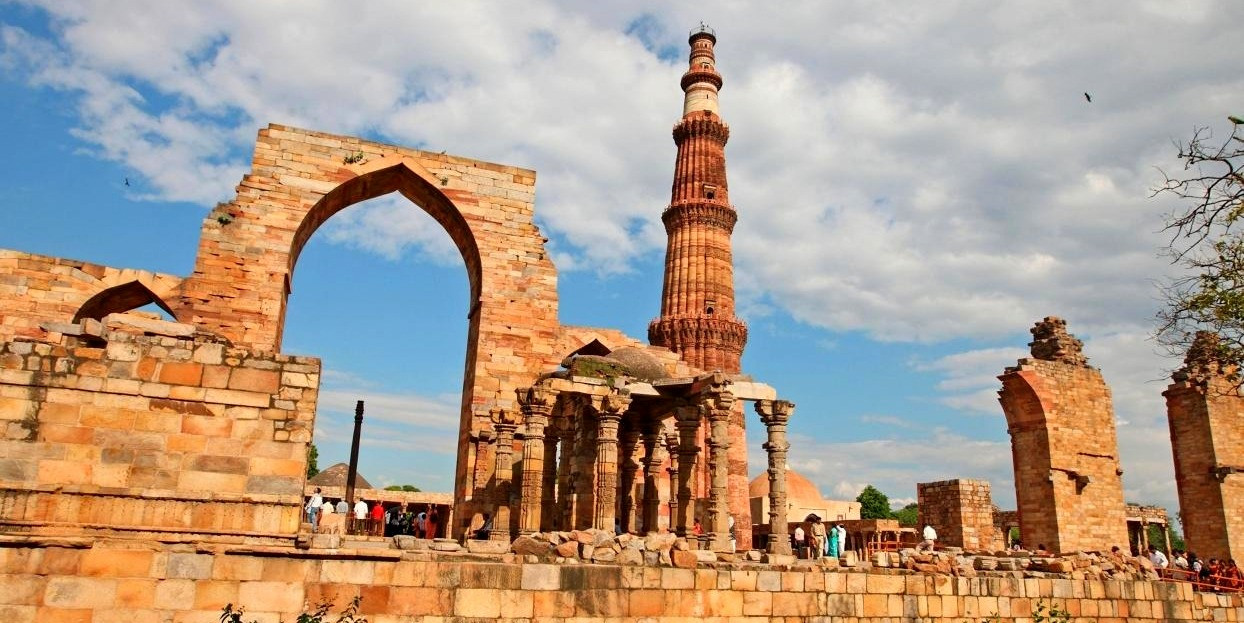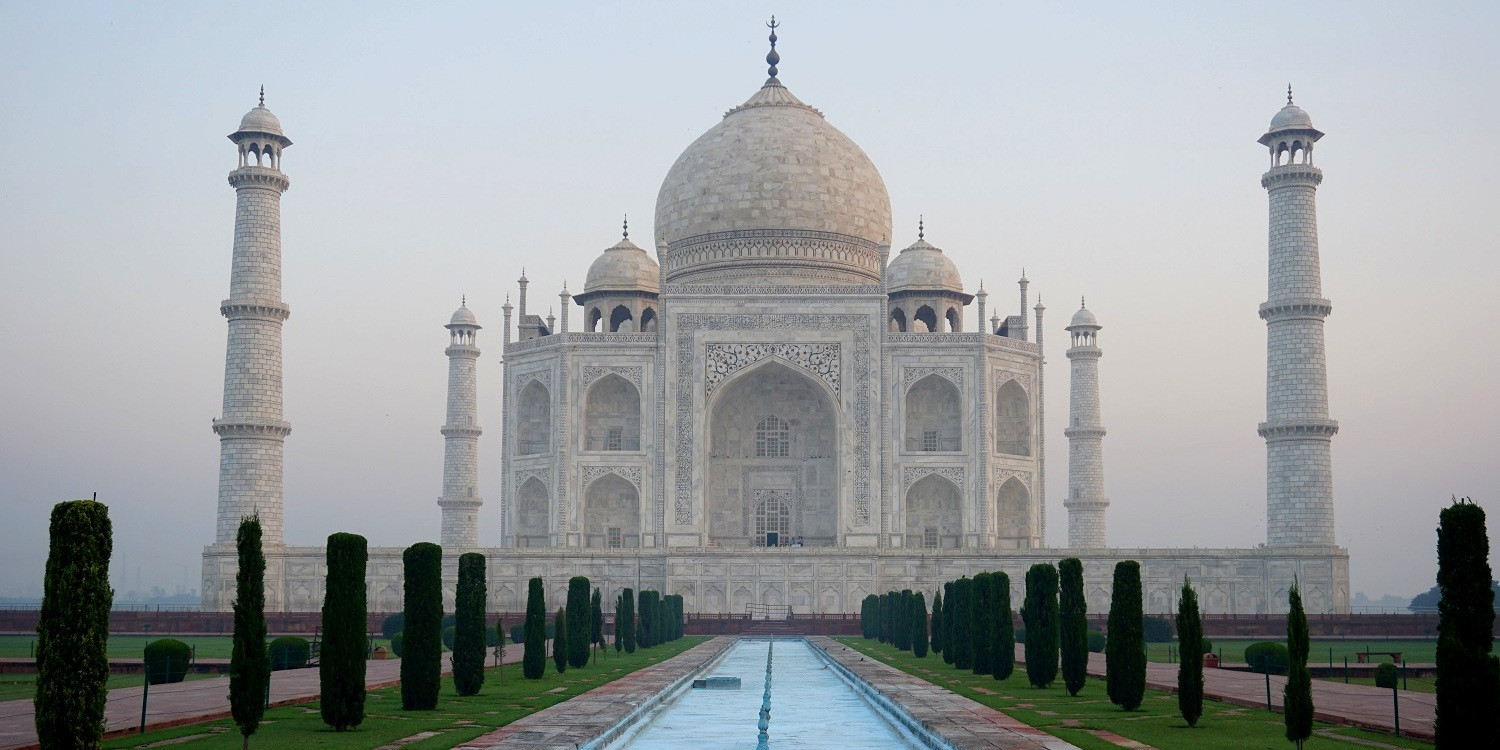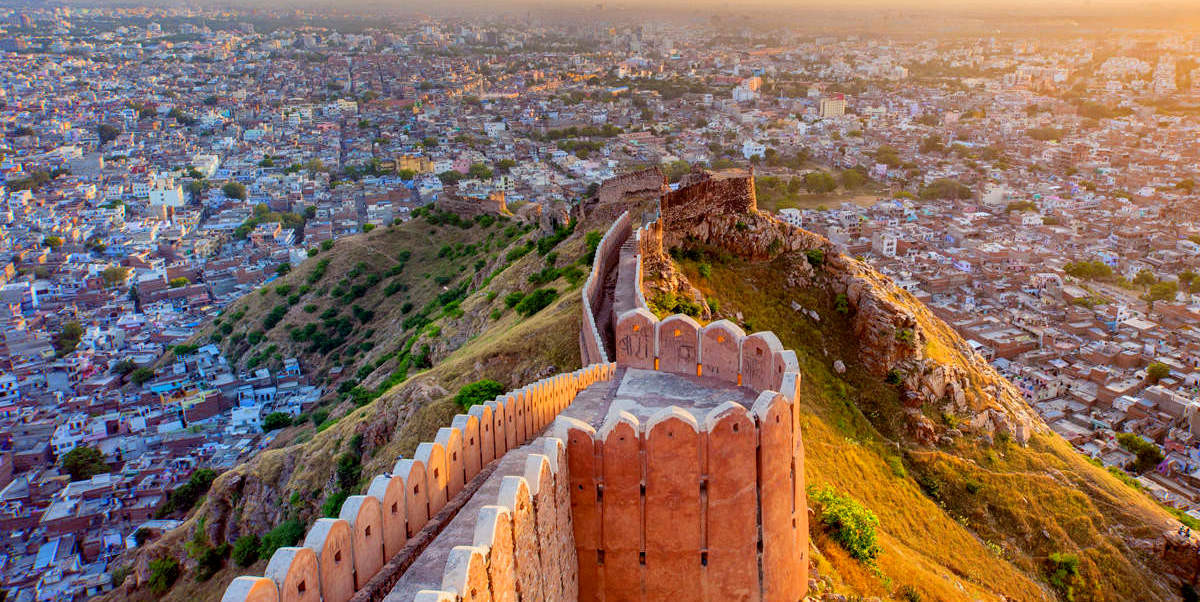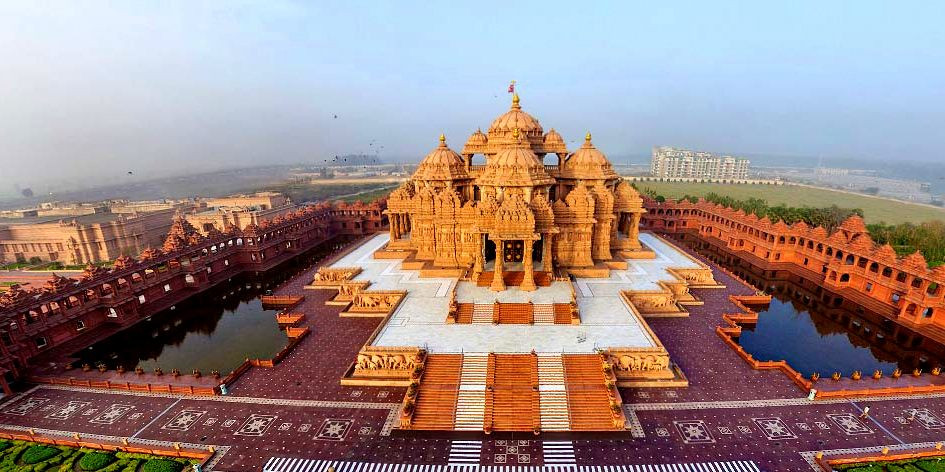Delhi
Delhi, the capital city of India, is a remarkable blend of antiquity and modernity, serving as a perfect reflection of the complex cultural diversity and history of India. It's a city where ancient monuments and temples coexist with bustling markets and contemporary infrastructure. Here are some key aspects and attractions of Delhi:

Historical Monuments
-
Red Fort: An iconic symbol of India, the Red Fort is a stunning piece of Mughal architecture made from red sandstone. It was built by Emperor Shah Jahan in the 17th century and continues to be a focal point of political events in India.
-
Qutub Minar: A UNESCO World Heritage Site, this 73-meter-high tower was constructed by Qutb-ud-din Aibak in 1193. It's celebrated for its intricate carvings and scriptures.
-
India Gate: Designed by Sir Edwin Lutyens, this 42-meter-high archway in the center of New Delhi is a war memorial dedicated to the soldiers of the Indian Army who died in World War I.
Cultural Sites
-
Humayun’s Tomb: Another UNESCO World Heritage Site, this is the tomb of the Mughal Emperor Humayun. It was the first garden-tomb on the Indian subcontinent, inspiring several major architectural innovations, culminating in the construction of the Taj Mahal.
-
Lotus Temple: Known for its flowerlike shape, the Lotus Temple is a Bahá'í House of Worship that is open to all, regardless of religion, or any other distinction.
Museums and Art
-
National Museum: One of the largest museums in India, it holds a variety of articles ranging from pre-historic era artifacts to modern works of art.
-
Crafts Museum: It celebrates traditional Indian crafts, textiles, and cultural heritage.
Markets and Shopping
-
Chandni Chowk: One of the oldest and busiest markets in Old Delhi, known for its spices, dried fruit, silver jewelry, and vivid saris.
-
Connaught Place: Known for its white colonnades, housing top brands, eateries, and offices in a circular design, making it a popular hub for shopping and entertainment.
Food
Green Spaces
- Lodi Gardens: A city park situated in New Delhi, spread over 90 acres, it contains, Mohammed Shah's Tomb, Tomb of Sikandar Lodi, Shisha Gumbad and Bara Gumbad, architectural works of the 15th century by Lodis.
Delhi is not just a city; it's a narrative that continues to evolve. Every corner of the city tells a story, reflecting the numerous empires that once ruled from the ramparts of the mighty Red Fort. Whether you are an enthusiast of history, art, or cuisine, Delhi provides a backdrop that combines the essence of ancient and contemporary India.
Agra
Agra, a city on the banks of the Yamuna River in the northern state of Uttar Pradesh, India, is synonymous with the majestic Taj Mahal, but it offers much more to the discerning traveler. This city, steeped in history and heritage, was once the heart of the Mughal Empire and today boasts several UNESCO World Heritage Sites alongside the Taj Mahal.

Key Attractions
-
Taj Mahal: A symbol of love, this iconic white marble mausoleum was built by Emperor Shah Jahan in memory of his wife Mumtaz Mahal. This masterpiece is one of the most recognized structures in the world and a prime example of Mughal architecture.
-
Agra Fort: Located near the gardens of the Taj Mahal, this powerful fortress of red sandstone encompasses within its 2.5-km-long enclosure walls, the imperial city of the Mughal rulers. It comprises many fairy-tale palaces, such as the Jahangir Palace and the Khas Mahal, built by Shah Jahan; audience halls, such as the Diwan-i-Khas; and two very beautiful mosques.
-
Fatehpur Sikri: About 35 km from Agra, this was once the capital of the Mughal Empire under Emperor Akbar. This city was built predominantly in red sandstone and combines influences from both Hindu and Mughal architecture. Key sites within Fatehpur Sikri include the Jama Masjid, Diwan-i-Am, Diwan-i-Khas, and the Panch Mahal.
Cultural Experience
-
Itmad-ud-Daulah's Tomb: Often referred to as the "Baby Taj", this tomb predates the Taj Mahal and is considered to have been a draft of the latter. It is the first tomb in India that is entirely made out of Marble.
-
Mehtab Bagh: These 11-acre gardens directly align with the Taj Mahal on the opposite side of the Yamuna River, providing a stunning view of the mausoleum. It's a popular spot for photographers.
Shopping and Crafts
-
Marble and Stone Carving: Agra is known for its marble inlay work, often seen in intricate designs on boxes, tabletops, and various trinkets. These make for excellent souvenirs and gifts.
-
Leather Products: Agra’s leather market is one of the largest in India. The city’s artisans are known for their high-quality leather footwear and handbags.
Culinary Delights
-
Petha: This soft candy made from white pumpkin or ash gourd is one of Agra’s most famous sweet treats.
-
Mughlai Cuisine: Reflecting the city’s rich Mughal heritage, Agra offers a wealth of rich and creamy dishes, including kebabs and curries that continue to draw food lovers from around the world.
Agra is not just a place to visit but to experience, offering a deep dive into the architectural and cultural heritage of the Mughal Empire. Its historical backdrop is filled with tales of romance, valor, and spirituality that resonate throughout its ancient alleys and landmarks.
Jaipur
Jaipur, famously known as the Pink City due to the distinct color of its buildings, is the capital of Rajasthan, India. This city is a gateway to India’s most flamboyant state and is part of the famous Golden Triangle Tour along with Delhi and Agra. Jaipur is renowned for its rich history, royal architecture, and vibrant, chaotic streets, offering an unforgettable cultural experience.

Major Attractions
-
Amber Fort: Perched on a hilltop, the fort is a stunning blend of Hindu and Mughal architecture made primarily from sandstone and marble. It features grand halls, temples, gardens, and the famous Sheesh Mahal (Mirror Palace).
-
City Palace: Located in the heart of the Old City, the palace complex features courtyards, gardens, and buildings with a blend of Rajasthani and Mughal architecture. It also houses a museum displaying historical costumes, weapons, and textiles.
-
Hawa Mahal (Palace of Winds): This iconic structure made of pink sandstone features a high screen wall that was designed so the women of the royal household could observe street festivals while unseen from the outside.
-
Jantar Mantar: An astronomical observation site built in the early 18th century, it features the world’s largest stone sundial, and is a UNESCO World Heritage site. It showcases an excellent blend of science and art.
Cultural Experience
-
Jaipur Literature Festival: Held annually, this is one of the most prestigious literary festivals in Asia, attracting authors, thinkers, and artists from around the world.
-
Folk Festivals and Art: Traditional festivals such as Teej, Diwali, and Holi are celebrated with great enthusiasm and offer a glimpse into the cultural richness of the region.
Shopping and Handicrafts
-
Johari Bazaar and Bapu Bazaar: These markets are famous for traditional Rajasthani jewelry and textiles, including gemstones, silver jewelry, and the vibrant leheriya and bandhani fabrics.
-
Blue Pottery: Known for its unique blue dye, Jaipur’s pottery is a sought-after decorative art that makes for distinctive souvenirs.
Culinary Delights
-
Rajasthani Cuisine: Known for its spicy curries and delicious sweets, local dishes like Dal Baati Churma, Laal Maas (red meat curry), and Ghevar are must-tries.
-
Street Food: Jaipur’s streets offer a plethora of tasty snacks, including kachoris, samosas, and mirchi bada.
Art and Craft
- Miniature Paintings and Textile Printing: Jaipur is also famous for its exquisite miniature paintings and beautifully crafted textiles, including block printing, tie-dye, and embroidery.
Jaipur not only captivates with its architectural marvels and historical significance but also enchants with its lively markets and rich artistic traditions. Whether you are exploring its grand palaces, wandering through its colorful bazaars, or savoring its culinary offerings, Jaipur promises a rich sensory and cultural experience.
Tips for Golden Triangle Tour in India
Golden Triangle Tour in India is an exhilarating experience, filled with the sights, sounds, and flavors of Delhi, Agra, and Jaipur. To ensure you have a smooth and enjoyable journey, here are some essential tips:
-
Plan Your Itinerary Wisely: Allocate enough time in each city to appreciate its unique attractions without feeling rushed. Typically, a minimum of 3 to 4 days in each city allows for a thorough exploration.
-
Best Time to Visit: The ideal time for the Golden Triangle Tour is between October and March when the weather is cooler and more comfortable for sightseeing.
-
Accommodations: Book your hotels in advance, especially if traveling during the peak season (November to February). Consider staying in heritage properties or luxury hotels to enhance your experience of the local culture and hospitality.
-
Transportation: Hiring a private car for the entire tour can offer flexibility and comfort. Ensure the driver is experienced and familiar with the routes. Alternatively, trains are a viable option between the cities.
-
Pack Appropriately: Bring comfortable walking shoes as you will spend a lot of time on your feet exploring forts, palaces, and markets. Dress conservatively to respect local customs, especially when visiting religious sites.
-
Stay Hydrated and Protect Yourself from the Sun: Carry a reusable water bottle, and always use sunscreen, a hat, and sunglasses during the day.
-
Respect Local Customs and Traditions: Be aware of the cultural nuances of each region. For instance, photography might not be allowed at certain religious sites.
-
Safety Precautions: Keep your valuables safe and be cautious of pickpockets, especially in crowded markets or tourist sites.
-
Try Local Cuisine: Each city in the Golden Triangle has its culinary specialties. Don't miss the chance to try local dishes and street foods, but make sure to eat at reputable places to avoid stomach upsets.
-
Shopping: The Golden Triangle is famous for its local handicrafts. Bargain respectfully but firmly, as it is a part of the shopping culture.
-
Guide Services: Hiring a knowledgeable guide can enrich your experience, especially at historical sites where the history adds immense value to the visit.
-
Health Precautions: Travel with a basic first-aid kit and medications you might need, as changing climates and cuisines can sometimes lead to minor health issues.
By following these tips, you’ll be better prepared to navigate the challenges and delights of the Golden Triangle, ensuring a memorable and enriching travel experience.
Ideal Time for Golden Triangle Tour in India
Exploring the Golden Triangle Tour in India by season can provide distinct experiences based on the climate and cultural events happening at that time. Here's a detailed breakdown:
Winter (December to February)
-
Weather: This is the coldest season, especially in January, with temperatures ranging from a chilly 2°C to a pleasant 20°C across the Golden Triangle cities. The cool weather is ideal for day-long sightseeing without the discomfort of heat and humidity.
-
Advantages: Clear skies and cooler temperatures make it the peak season for tourism. The pleasant weather is perfect for exploring outdoor historical sites and spending time in busy markets.
-
Cultural Events: Enjoy the Republic Day celebrations in Delhi at the end of January, which features a grand parade showcasing India's military and cultural diversity.
Spring (March to April)
-
Weather: The temperature begins to rise, but it remains comfortable, ranging from 15°C to 30°C. The early part of spring is still pleasant before the heat sets in.
-
Advantages: The landscape starts to bloom, and there is less tourist traffic compared to winter, making it a good time to explore if you prefer avoiding large crowds.
-
Cultural Events: Holi, the festival of colors, typically falls in March. It's a vibrant and energetic festival where locals and tourists alike throw colored powders and celebrate with music and dance.
Summer (May to June)
-
Weather: Summer in the Golden Triangle can be very hot, with temperatures often soaring above 40°C. The heat can be intense, especially in the afternoons.
-
Advantages: Fewer tourists visit during this time, which can translate to better deals on accommodations and tours.
-
Considerations: It's essential to plan activities in the early morning or late afternoon to avoid the midday heat. Staying hydrated and wearing sunscreen is crucial.
Monsoon (July to September)
-
Weather: The monsoon season brings heavy rains and high humidity, with temperatures ranging between 25°C and 35°C. Rainfall can vary but expect frequent downpours.
-
Advantages: The rain brings relief from the previous months' heat and rejuvenates the landscape, making it lush and green.
-
Considerations: Sightseeing can be disrupted by rainfall, so it’s advisable to have flexible plans. This is also a great time to enjoy the fewer crowds and the scenic, rain-washed vistas of the forts and palaces.
Autumn (October to November)
-
Weather: Autumn marks the retreat of the monsoon and the return of mild weather, with temperatures ranging from 15°C to 30°C.
-
Advantages: The weather is comfortable, and the clear skies return, making it an excellent time for photography and all-day excursions.
-
Cultural Events: Diwali, the Festival of Lights, occurs in October or November. The cities light up with beautiful decorations, fireworks, and celebrations, providing a festive atmosphere.
Each season offers a unique way to experience the Golden Triangle, with varying weather conditions and cultural events enhancing your visit. Whether you prefer the festive winter atmosphere, the colorful celebrations of spring, or the lush landscapes post-monsoon, there's a perfect time for everyone to explore this vibrant tour.
The Golden Triangle Tour encapsulates the essence of India's rich heritage, offering a deep dive into the heart of Delhi's bustling energy, Agra's iconic grandeur, and Jaipur's royal majesty. This journey through the three most culturally vibrant cities in North India provides a perfect blend of history, architecture, and tradition, making it an unforgettable experience for any traveler. Whether you're exploring ancient palaces, marveling at the Taj Mahal, or navigating the colorful bazaars, the Golden Triangle Tour is an essential exploration of India’s enduring allure.
FAQs for Golden Triangle Tour in India
Q: What is the Golden Triangle in India?
A: The Golden Triangle refers to the popular tourist circuit connecting Delhi, Agra, and Jaipur. These cities form a triangle on the map and are celebrated for their profound historical significance, stunning architecture, and vibrant cultures.
Q: How long does it take to complete the Golden Triangle Tour?
A: The tour typically lasts between 4 to 7 days, depending on the time spent in each city and the overall pace of your travel.
Q: What is the best time to visit the Golden Triangle?
A: The optimal time to visit is from October to March, during the cooler months, which offer a more comfortable climate for exploring.
Q: Do I need a visa to visit India for the Golden Triangle Tour?
A: Yes, international visitors need a visa. Most tourists can apply for an e-Visa, available through an online application before arrival.
Q: What are the transportation options within the Golden Triangle?
A: You can choose from private cars, taxis, trains, and buses. Private cars are recommended for flexibility and comfort, particularly for those visiting for the first time.
Q: What kind of accommodations can I expect?
A: There are diverse accommodation options ranging from budget guesthouses to luxurious hotels. Heritage hotels in Jaipur are particularly unique, offering a taste of local tradition and history.
Q: Is it safe to travel within the Golden Triangle?
A: Yes, traveling within the Golden Triangle is generally safe. Still, standard travel precautions should be observed—protect your belongings, stay vigilant in crowded areas, and use reputable transport services.
Q: What should I pack for the tour?
A: Pack light with comfortable clothing suitable for variable temperatures. Essentials include good walking shoes, a hat, sunscreen, and a reusable water bottle.
Q: Can I book the Golden Triangle Tour online?
A: Yes, you can book the tour online through various platforms. Compare different packages on reputable travel websites or book directly with local agencies like Relax Getaways for the best experience.
For the Nepal tour, please click here.
If you are looking for different kinds of Nepal Tours or Trekking Packages, feel free to contact us.




